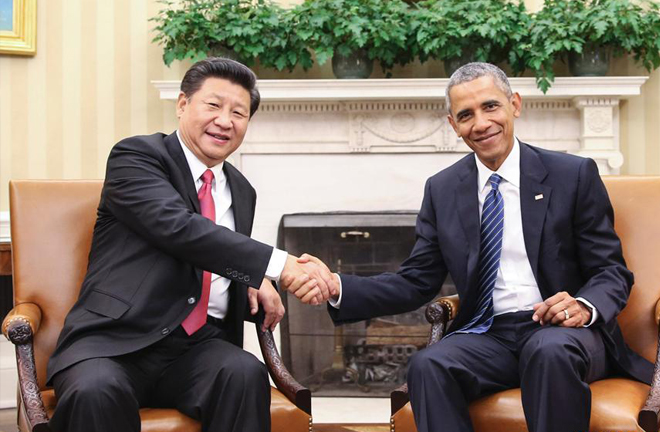Scholars hail Xi's first state visit to US

Chinese President Xi Jinping talks with US President Barack Obama in Washington on Sept. 25, 2015.
Chinese President Xi Jinping paid a state visit to the US at the invitation of US President Barack Obama from Sept. 22 to 25. Scholars have weighed in on the trip, saying that it has injected strong impetus into what has been dubbed the “new type of major-country ties” between China and the US, as well as reinvigorating regional and international situations.
This was Xi’s first state visit to the US since he took office. On the night of Sept. 24, Xi and his US counterpart exchanged views on governance, bilateral ties and other issues of common concern in a three-hour talk in the Blair House.
On Sept. 25, the two presidents reached a consensus on an extensive range of issues and arrived at a series of outcomes. Both sides spoke highly of important achievements made in bilateral relations since the 2013 Sunnylands meeting and agreed to, based on consensus, expand bilateral, regional and global pragmatic cooperation and control disparities and sensitive issues by constructive means to consistently make new achievements.
Before Xi kicked off his visit, Chinese Foreign Minister Wang Yi suggested that enhancing mutual trust and removing misgivings was an important focal point of Xi’s tour.
Academics anticipated that Xi could clarify China’s commitment to peaceful development and win-win cooperation, make clear the mutual benefits of cooperation and negative outcomes of confrontation, and dispel the US’s fear of conflict between the two countries in the international system and regional order.
The in-depth discussions between the two presidents undoubtedly reduced suspicion about each other and deepened mutual trust, scholars said.
In recent months, there have been concerns in academia that China and the US may fall into the "Thucydides trap," a theory in which a rising power is believed likely to confront an established one.
Pointing out that China is a participator, constructor, contributor as well as a beneficiary of the existing international system, Xi said reforming and adjusting the current system is not about creating a new one, but aims to make it more just and rational.
Obama said he doesn't believe in the Thucydides trap, urging major countries, the US and China in particular, to avoid conflict.
Obama said he is confident that the US and China have the ability to manage differences, and that competition between the two countries can be constructive and positive.
William Kirby, a professor of China Studies at Harvard University, stressed the long history of US-China exchanges, saying that the two sides have converged in many spheres with a lot of common interests.
He disagreed that the US-China relationship is at a so-called “critical point.” Looking back into the past, bilateral ties have gone through highs and lows and were at times even more strained than now. “Some people work to ‘exaggerate,’ so these worries are unnecessary,” he said.
Robert Keohane, a professor of International Affairs at Princeton University, echoed this, saying that discord between China and the US shouldn’t be overstated. It would be a utopian fantasy to expect a perfectly harmonious relationship so we shouldn’t be disheartened by friction, he said.
Dialogue and cooperation have always been the theme of the China-US relationship. The two countries have built more than 90 inter-governmental dialogue and cooperation mechanisms. Within decades, the volume of bilateral trade has jumped to $555.1 billion and investment in various fields has amounted to $120 billion, starting from almost zero.
China has become US’s second-largest trade partner, third-largest export market and largest source of imports, while the US has become China’s second-largest trade partner, largest export market and fifth-largest source of imports.
“The more fields China and the US cooperate in, the more achievements they make, the greater the momentum of development in bilateral ties,” said Wu Xinbo, executive director of the Collaborative Innovation Center for New Model of Sino-US Major Power Relationship at Fudan University.
Since the 2013 Sunnylands meeting, when the two state leaders agreed to establish a new model of major-country ties, the relationship has achieved early results. “The new model for a major–country relationship doesn’t consist of mere concepts, but has brought real, tangible benefits,” Wu said.
People often pay attention to problems in the China-US relations and turn a blind eye to achievements. Summarizing recent progress made in the bilateral relationship will be favorable in terms of enhancing the US’s identity by building a new model of major-country ties, he added.
Chinese scholars are full of expectations for the future of the new model of China-US major-country ties. “Success in building the new model of major-country relationship will depend on the interactions between the two sides of the Asia-Pacific region,” Wu said.
The joint construction of the Asia-Pacific free trade zone will help bring up inclusive, cooperative and win-win situations in the Asia-Pacific. In the common interests of the two countries and the region at large, the vision can also garner bipartisan support from the US and instill enduring vitality into the building of the major-country relationship, he said.
Mao Li and Feng Daimei are reporters at the Chinese Social Sciences Today.
